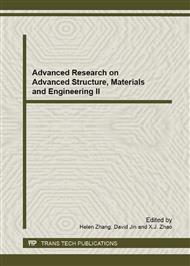p.217
p.221
p.225
p.231
p.235
p.239
p.243
p.247
p.251
Study on Building Engineering with Simulation and Analysis of Outdoor Thermal Environment for a Residential Subdistrict in Hot Summer/Cold Winter Region
Abstract:
Thermal environmental problems in urban high-rise buildings are prevalent. To analyze the phenomenon, the thermal environment of a typical urban residential subdistrict is simulated by using CFD techniques considering the affects of different type of wall material. The simulation data are carefully analyzed. Some useful results are thus obtained. The direction of the buildings affects air circulation greatly with the north-south orientation having the best effects. Temperature in the subdistrict is about 3~5°C higher than its surroundings because of heat island effects which could be weakened if greening rate of the sbudistrict is increased. Finally, simulation results show that wall materials affect the environment considerably.
Info:
Periodical:
Pages:
235-238
Citation:
Online since:
May 2013
Authors:
Price:
Сopyright:
© 2013 Trans Tech Publications Ltd. All Rights Reserved
Share:
Citation:


